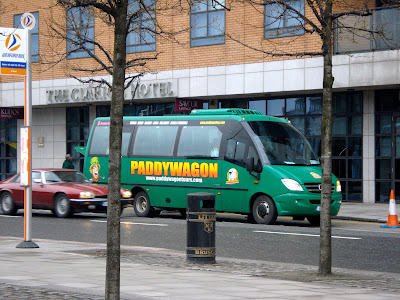In my first post, I said that I hoped "to create an archive of photos that would capture the diversity of experiences with the everyday need to travel around the city." My project would be focused on two central themes: social interactions between various groups who participate in the same kinds of public transportation together, and the ways in which transportation indicates globalization of a city like Dublin.
The basis for my belief that I would witness an interesting variety of social interactions was that regardless of occupation and within a very wide range of people, the bus, train, and road are interesting spaces that bring together students, adults, families, residents and tourists who might otherwise never interact in their day-to-day business. Residents of the same city can live lives that barely resemble one another's, but transportation is one of the everyday needs that seems to be a preoccupation across the board.
Secondly, I thought urban transportation systems were worth exploring because they are an indicator of and a tool for globalization. While globalization brings with it the increased ability to work with colleagues worldwide, breaking down many previously impervious spacial barriers, there is still an importance for the ease of crossing spaces when they are proximal (ie. in the same city.) At the same time, access to reliable international travel helps businesspeople in Dublin cooperate with their colleagues worldwide not only online, but through frequent or at least regular visits.

The process of making the archive has further shown me that Dublin has a wide variety of residents and visitors who utilize public transit each day. While I did not always capture exactly what I was expecting, I think that was to be expected since I was shooting in a relatively new place. For instance, sometimes I went to a good location at the wrong time of day, or didn't know whether it would be appropriate to take photos in certain settings or times, or lacked access (for example, in the airport). Therefore, sometimes I did not get the shots I was expecting, but the archive still fits my ethnography because it is the way I, as a newcomer, have seen and experienced public transit here in Dublin.
I learned that it was much easier to capture modes of transport (tending toward the second theme, of globalization and transportation systems in place) than it was to capture people in transport, at least in so far as those people were interacting. The photos I got of large groups of people captured the urban rush of a cosmopolitan area, but I did not encounter as many clear instances of different groups together on the same mode of transit as I initially hoped. Therefore, I think my archive more effectively illustrates the spaces in which people interact than those actual interactions.
I think making our own ethnographies probably helped to clarify some of the theory we covered in the first half of the semester. For instance, we earlier discussed the relationship between denoted and connoted messages, but I now can look through my photographs and pick out images in which I was trying to suggest something that couldn't exactly be captured in the frame.
I can definitely see myself using a visual ethnography as a methodology for a larger future project, such as an undergraduate thesis. I could see myself, particularly, exploring more in depth the way transportation affects quality of life in urban settings and the way people relate to one another within a daily practice like the commute and within occasional practices like tourism. I would like to see whether people say they prefer the kinds of transportation that bring different groups together (such as busses and subway systems). I would also see whether they would choose to live in a city that primarily uses automobile transportation, or whether they would find that to be alienating.

This project could go on much longer to more fully represent the experiences of those who use public transportation in Dublin on a regular or an occasional basis, but my archive has taken shape in a way that has represented certain types of transportation and the people who utilize it. As Sarah Pink wrote in "The Visual in Ethnography", one of the most important considerations for the visual researchers of today is the mobility of subjects or informants. She references Vared Amit, who "has pointed out, 'the people whom they [ethnographers] are trying to study are increasingly likely to be as mobile if not more so than the ethnographers trying to keep up with them.'" This speaks to both the challenge and the reasoning behind my project. Dublin's identity is shifting toward that of an ever more globalized city. The everyday movement of its residents and visitors from place to place is an important factor in this shift, so by building an ethnography-- an archive of photos that create and represent my knowledge of Dublin transportation based on my experience as a newcomer to the city- I hope to have captured in some way the way Dubliners relate to their experience of moving about, in, and out of the city.


























































